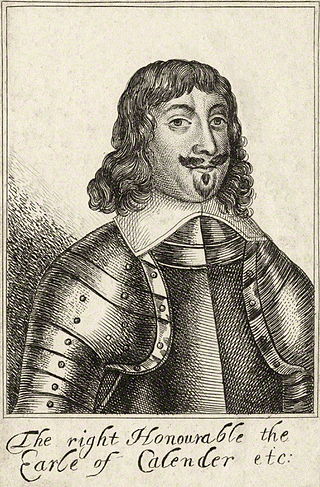There are currently two earldoms of Mar in the Peerage of Scotland, and the title has been created seven times. The first creation of the earldom is currently held by Margaret of Mar, 31st Countess of Mar, who is also clan chief of Clan Mar. The seventh creation is currently held by James Erskine, 14th Earl of Mar and 16th Earl of Kellie, who is also clan chief of Clan Erskine.

Marquess of Linlithgow, in the County of Linlithgow or West Lothian, is a title in the Peerage of the United Kingdom. It was created on 23 October 1902 for John Hope, 7th Earl of Hopetoun. The current holder of the title is Adrian Hope.

Earl of Erroll is a title in the Peerage of Scotland. It was created in 1453 for Sir William Hay. The subsidiary titles held by the Earl of Erroll are Lord Hay and Lord Slains (1452), both in the Peerage of Scotland. The Earls of Erroll also hold the hereditary office of Lord High Constable of Scotland. The office was once associated with great power. The Earls of Erroll hold the hereditary title of Chief of Clan Hay.

Earl of Perth is a title in the Peerage of Scotland. It was created in 1605 for James Drummond, 4th Lord Drummond. The Drummond family claim descent from Maurice, son of George, a younger son of King Andrew I of Hungary. Maurice arrived in Scotland on the ship which brought Edgar Ætheling, the Saxon claimant to the crown of England after the Norman Conquest, and his sister Margaret to Scotland in 1068. Maurice was given lands in Lennox (Dunbartonshire), together with the hereditary stewardship of the county. The Hungarian Prince theory has been discounted as no evidence of any relationships exists in written records or DNA. "The Red Book of the Menteiths" clearly discounts the Hungarian Prince as a myth likely formed to give status to the Drummond origins. The Drummonds in the 12th century were allied to the Menteiths – their early fortunes developed through the relationship. Indeed, one "Johannes De Drumon", said to have died in 1301, was buried in Inchmahome Priory which was founded by the Menteiths. His successor John Drummond, the 7th Steward, was deprived of the lands and retired into Perthshire.

Earl of Southesk is a title in the Peerage of Scotland. It was created in 1633 for Sir David Carnegie, an Extraordinary Lord of Session. He had already been created Lord Carnegie of Kinnaird in 1616 and was made Lord Carnegie, of Kinnaird and Leuchars, at the same time he was given the earldom. These titles are also in the Peerage of Scotland. The earldom is named after the River South Esk in Angus. Carnegie's younger brother John Carnegie was given the corresponding title: earl of Northesk. The earl of Southesk also holds the Scottish feudal title of Baron of Kinnaird and is a baronet in the Baronetage of Nova Scotia. Kinnaird Castle, Brechin, has been the home of the earls of Southesk for several hundred years.

Earl of Leven is a title in the Peerage of Scotland. It was created in 1641 for Alexander Leslie. He was succeeded by his grandson Alexander, who was in turn followed by his daughters Margaret and Catherine. Thereafter, there was a dispute relating to succession to the title between David Melville and John Leslie, 1st Duke of Rothes. However, in 1681, Melville's claim was admitted after the Duke of Rothes died. In 1707, Melville succeeded to the title Earl of Melville, and thereafter the earldoms have been united.

Earl of Linlithgow was a title in the Peerage of Scotland. It was created in 1600 for Alexander Livingston, 7th Lord Livingston, along with the subsidiary title of Lord Livingston and Callendar. In 1695, the Earldom of Linlithgow merged with the junior Earldom of Callendar, which had been created in 1641 for a younger son of the 1st Earl.

James Hay, 15th Earl of Erroll styled Lord Boyd from 1728 to 1746, was a Scottish nobleman and the son of William Boyd, 4th Earl of Kilmarnock.

Callendar House is a mansion set within the grounds of Callendar Park in Falkirk, central Scotland. During the 19th century, it was redesigned and extended in the style of a French Renaissance château fused with elements of Scottish baronial architecture. However, the core of the building is a 14th-century tower house.
James Livingston may refer to:
Alexander Livingston, 5th Lord Livingston of Callandar PC was the guardian of Mary, Queen of Scots, during her childhood.

James Livingston, 1st Earl of Callendar, was a Scottish army officer who fought on the Royalist side in the Wars of the Three Kingdoms.
George Livingston PC was a military officer and third Earl of Linlithgow.
Alexander Livingston, 1st Earl of Linlithgow PC was a Scottish nobleman, courtier, and politician. His wife was Helenor Hay, Countess of Linlithgow who was a Royal tutor.
Helenor Hay, Countess of Linlithgow was a Scottish courtier and writer.
William Livingston, 4th Lord Livingston of Callandar was a Scottish nobleman.

James Livingston, 5th Earl of Linlithgow, 4th Earl of Callendar was a Scottish nobleman who was convicted of high treason and forced to forfeit his estates and all his titles to the Crown.
Alexander Livingston, 2nd Earl of Linlithgow PC was a Scottish nobleman.
Alexander Livingston, 3rd Earl of Callendar was a Scottish nobleman.

Colonel George Hay, 16th Earl of Erroll was a Scottish peer and soldier.








